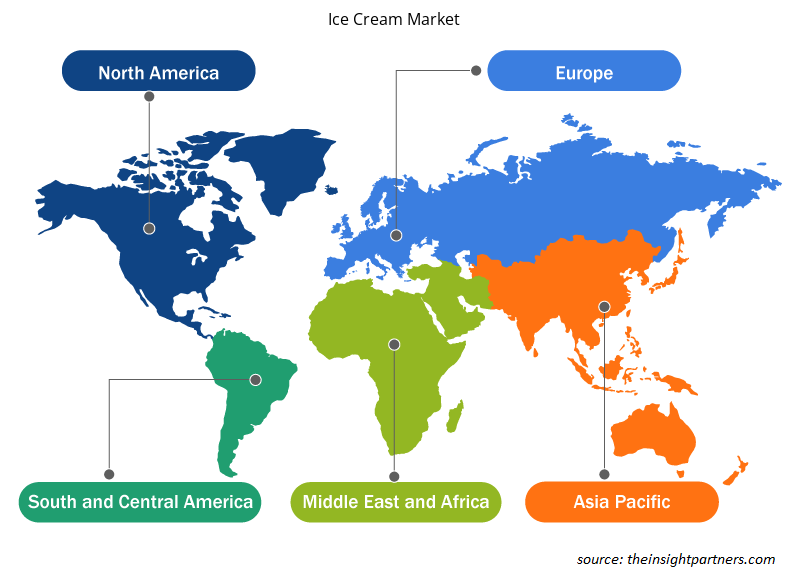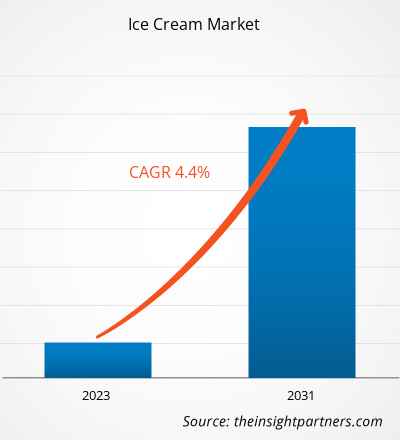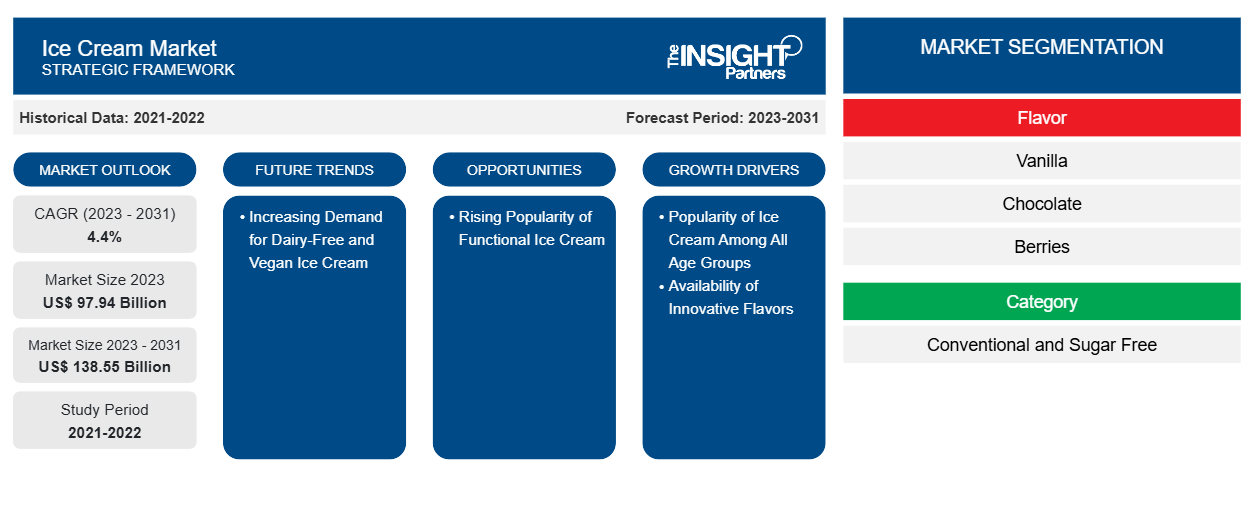Se proyecta que el tamaño del mercado de helados alcance los 138.550 millones de dólares en 2031, frente a los 97.940 millones de dólares en 2023. Se espera que el mercado registre una CAGR del 4,4 % durante el período 2023-2031. Es probable que la creciente demanda de helados sin lácteos y veganos actúe como una tendencia clave en el mercado.CAGR of 4.4% during 2023–2031. The increasing demand for dairy-free and vegan ice cream is likely to act as a key trend in the market.
Análisis del mercado de helados
El aumento de la demanda de helados de primera calidad, la disponibilidad de diversos sabores y el aumento de la preferencia por los ingredientes naturales y sin conservantes son algunos de los factores que impulsan el crecimiento del mercado de los helados . La demanda de helados naturales bajos en grasas con un gran sabor y un alto grado de placer está aumentando en Europa. La creciente preferencia por los postres helados como ayuda digestiva después de las comidas impulsa la demanda de estas delicias. El creciente interés de los fabricantes de helados en la fortificación y la adición de ingredientes funcionales puede influir en la decisión del consumidor de seleccionar una alternativa saludable. Más allá de la nutrición básica, los alimentos funcionales proporcionan ventajas que pueden ayudar a reducir o prevenir el riesgo de ciertas enfermedades. Además, los helados funcionales sin azúcar y bajos en grasas están ganando una enorme popularidad debido a sus beneficios para la salud.
Descripción general del mercado de helados
El helado es un postre popular y está disponible en varios sabores. El crecimiento del mercado del helado está impulsado por la disponibilidad de helados de varios sabores, especialmente sabores de frutas de temporada, y el aumento de las innovaciones de sabor por parte de los fabricantes. Recientemente, el helado funcional se ha vuelto popular entre los consumidores preocupados por la salud, ya que contiene ingredientes de alta calidad y satisface los requisitos nutricionales de los consumidores más que el helado normal. Por lo tanto, el creciente interés de los fabricantes de helados en la fortificación y la adición de ingredientes funcionales puede influir en la decisión del consumidor de seleccionar una alternativa saludable. Además, los helados funcionales sin azúcar y bajos en grasa están ganando una gran popularidad debido a sus beneficios para la salud. Los actores clave en el mercado de helados incluyen Blue Bell Creameries, Unilever Plc, Nestle SA, General Mills Inc, Mars Inc, Wells Enterprises, Turkey Hill Dairy, Dairy Farmers of America Inc, Cold Stone Creamery, Morinaga Milk Industry Co Ltd, Kwality Foods LLC, Baskin-Robbins, David Chapman's Ice Cream Limited, Lotus Bakeries NV e IMURAYA GROUP CO., LTD.
Personalice este informe según sus necesidades
Obtendrá personalización en cualquier informe, sin cargo, incluidas partes de este informe o análisis a nivel de país, paquete de datos de Excel, así como también grandes ofertas y descuentos para empresas emergentes y universidades.
-
Obtenga las principales tendencias clave del mercado de este informe.Esta muestra GRATUITA incluirá análisis de datos, desde tendencias del mercado hasta estimaciones y pronósticos.
Factores impulsores y oportunidades del mercado de helados
Disponibilidad de sabores innovadores
Los fabricantes de helados están desarrollando productos con componentes nutricionales, rellenos de hierbas orgánicas y sabores exóticos en la formulación del producto para obtener una ventaja competitiva y atraer a más consumidores. Los fabricantes están introduciendo sabores exóticos como coco, limón y frutas tropicales para adaptarse a las cambiantes preferencias gustativas de los consumidores. Además, los consumidores están preocupados por su salud. Por ello, los fabricantes están modificando los ingredientes utilizados en los productos en función de las preferencias de los consumidores e introduciendo nuevos productos para diferenciar sus ofertas. Ben & Jerry's lanzó un helado con aditivos de CBD. Además, el helado de licor está ganando popularidad en todo Estados Unidos. Estos productos contienen menos del 0,5% de alcohol; por lo tanto, se venden ampliamente en supermercados y tiendas especializadas. En septiembre de 2021, Häagen-Dazs lanzó un helado con infusión de licor con un sabor de cinco pintas tradicionales elaborado con crema irlandesa, ron, bourbon y cerveza negra. Además, en noviembre de 2023, LiQ y Baileys firmaron un acuerdo de asociación para lanzar pralinés de helado con infusión de licor.CBD additives. Further, liquor ice cream is gaining popularity across the US. These products contain less than 0.5% alcohol; therefore, they are widely retailed in grocery and specialty stores. In September 2021, Häagen-Dazs launched a spirit-infused ice cream with a flavor of five traditional pints made with Irish cream, rum, bourbon, and stout. In addition, in November 2023, LiQ and Baileys entered into a partnership agreement to launch liquor-infused ice cream pralines.
La creciente popularidad del helado funcional
La popularidad de los helados funcionales se debe principalmente a las innovaciones de los productos, especialmente en términos de perfil de sabor y valor nutricional. En agosto de 2022, la marca de helados de culto de California y favorita de las celebridades, Coolhaus, hizo su debut en Singapur con seis sabores. Estos lanzamientos de productos funcionales ayudan a los consumidores a seguir y mantener sus objetivos de salud y disfrutar de una buena comida al mismo tiempo, ya que la salud se convirtió en una prioridad para los consumidores durante la crisis de COVID-19. Dado que las personas han comenzado a centrarse en los productos alimenticios de conveniencia manteniendo al mismo tiempo el equilibrio nutricional en sus dietas, los fabricantes están lanzando helados enriquecidos nutricionalmente. Estas innovaciones de productos los ayudan a ampliar su alcance y obtener una ventaja competitiva en los mercados regionales. Por lo tanto, se espera que la creciente demanda de helados funcionales cree oportunidades lucrativas para el mercado de los helados en los próximos años.Coolhaus made its debut in Singapore with six flavors. These launches of functional products help consumers follow and maintain their health goals and enjoy a good meal simultaneously, as health became a priority for consumers during the COVID-19 crisis. Since people have started focusing on convenience food products while maintaining the nutritional balance in their diets, manufacturers are launching nutritionally enriched ice creams. Such product innovations help them extend their reach and gain a competitive edge in regional markets. Thus, the rising demand for functional ice creams is expected to create lucrative opportunities for the ice cream market in the coming years.
Informe de mercado de helados Análisis de segmentación
Los segmentos clave que contribuyeron a la derivación del análisis del mercado de helados son el sabor, la categoría, la forma y el canal de distribución.
- Según el sabor, el mercado de helados se segmenta en vainilla, chocolate, frutos del bosque, matcha y otros. El segmento de chocolate tuvo la mayor participación de mercado en 2023.
- Por categoría, el mercado se divide en convencional y sin azúcar. El segmento convencional tuvo una mayor participación en el mercado en 2023.
- En cuanto a la forma, el mercado está segmentado en vasos y tarros, barras y palitos, entre otros. El segmento de vasos y tarros dominó el mercado en 2023.
- Según el canal de distribución, el mercado de helados se segmenta en supermercados e hipermercados, tiendas especializadas, venta minorista en línea y otros. El segmento de supermercados e hipermercados tuvo la mayor participación de mercado en 2023.
Análisis de la cuota de mercado de helados por geografía
El alcance geográfico del informe del mercado de helados se divide principalmente en cinco regiones: América del Norte, Asia Pacífico, Europa, Medio Oriente y África, y América del Sur y Central.
En 2023, Asia Pacífico tuvo la mayor participación en el mercado de helados. La disponibilidad de helados de diversos sabores, especialmente sabores de frutas de temporada, y las innovaciones de sabor por parte de los fabricantes impulsan el mercado de helados en Asia Pacífico. Además, se espera que la inclinación de los consumidores hacia los productos de origen vegetal debido a la creciente adopción de productos más saludables cree nuevas tendencias de helados de origen vegetal y veganos en el mercado de helados de Asia Pacífico durante el período de pronóstico. La creciente demanda de helados veganos ha dado lugar a la innovación y el lanzamiento de helados de origen vegetal en la región. Por ejemplo, en noviembre de 2023, OATSIDE, un fabricante de leche de avena de Singapur, presentó una línea de helados veganos en tres sabores disponibles en los principales minoristas de todo el país. El aumento de los ingresos disponibles, la rápida urbanización y el aumento del nivel de vida también impulsan el crecimiento del mercado de helados. Los consumidores también buscan alimentos más saludables y nutritivos, lo que genera una mayor demanda de helados con probióticos, prebióticos e ingredientes funcionales.
Perspectivas regionales del mercado del helado
Los analistas de Insight Partners explicaron en detalle las tendencias y los factores regionales que influyen en el mercado de helados durante el período de pronóstico. Esta sección también analiza los segmentos y la geografía del mercado de helados en América del Norte, Europa, Asia Pacífico, Oriente Medio y África, y América del Sur y Central.

- Obtenga los datos regionales específicos para el mercado de helados
Alcance del informe sobre el mercado de helados
| Atributo del informe | Detalles |
|---|---|
| Tamaño del mercado en 2023 | US$ 97,94 mil millones |
| Tamaño del mercado en 2031 | US$ 138,55 mil millones |
| CAGR global (2023 - 2031) | 4,4% |
| Datos históricos | 2021-2022 |
| Período de pronóstico | 2023-2031 |
| Segmentos cubiertos |
Por sabor
|
| Regiones y países cubiertos |
América del norte
|
| Líderes del mercado y perfiles de empresas clave |
|
Densidad de actores del mercado de helados: comprensión de su impacto en la dinámica empresarial
El mercado de helados está creciendo rápidamente, impulsado por la creciente demanda de los usuarios finales debido a factores como la evolución de las preferencias de los consumidores, los avances tecnológicos y una mayor conciencia de los beneficios del producto. A medida que aumenta la demanda, las empresas amplían sus ofertas, innovan para satisfacer las necesidades de los consumidores y aprovechan las tendencias emergentes, lo que impulsa aún más el crecimiento del mercado.
La densidad de actores del mercado se refiere a la distribución de las empresas o firmas que operan dentro de un mercado o industria en particular. Indica cuántos competidores (actores del mercado) están presentes en un espacio de mercado determinado en relación con su tamaño o valor total de mercado.
Las principales empresas que operan en el mercado de helados son:
- Lecherías Blue Bell
- Unilever Plc
- Nestlé SA
- General Mills Inc
- Marte Inc.
- Empresas Wells
Descargo de responsabilidad : Las empresas enumeradas anteriormente no están clasificadas en ningún orden particular.

- Obtenga una descripción general de los principales actores clave del mercado de helados
Noticias y novedades del mercado de helados
El mercado de helados se evalúa mediante la recopilación de datos cualitativos y cuantitativos a partir de una investigación primaria y secundaria, que incluye publicaciones corporativas importantes, datos de asociaciones y bases de datos. A continuación, se enumeran algunos de los avances en el mercado de helados:
- Blue Bell Creameries amplió su área de distribución para incluir St. Louis y ciudades aledañas a partir de marzo de 2024. Se está construyendo una instalación de distribución de 16.000 pies cuadrados en 11400 Spencer Road en St. Peters, Missouri. No se fabricarán productos en el lugar, pero habrá una cámara frigorífica para los dulces congelados. Blue Bell utiliza la entrega directa a la tienda, lo que garantiza que solo sus empleados manipulen el producto desde la producción hasta los estantes de las tiendas. (Fuente: Blue Bell Creameries, sitio web de la empresa, noviembre de 2023)
- Magnum lanzó un minipack de helado vegano y una receta nueva y mejorada para su gama principal vegana. (Fuente: Unilever Plc, comunicado de prensa, enero de 2023)
Informe sobre el mercado de helados: cobertura y resultados
El informe "Tamaño y pronóstico del mercado de helados (2021-2031)" proporciona un análisis detallado del mercado que cubre las siguientes áreas:
- Tamaño del mercado de helados y pronóstico a nivel mundial, regional y nacional para todos los segmentos clave del mercado cubiertos bajo el alcance
- Tendencias del mercado de helados, así como dinámicas del mercado, como impulsores, restricciones y oportunidades clave
- Análisis detallado de las cinco fuerzas de Porter y FODA
- Análisis del mercado de helados que abarca las tendencias clave del mercado, el marco global y regional, los principales actores, las regulaciones y los desarrollos recientes del mercado.
- Panorama de la industria y análisis de la competencia que abarca la concentración del mercado, análisis de mapas de calor, actores destacados y desarrollos recientes para el mercado de helados
- Perfiles detallados de empresas
- Análisis histórico (2 años), año base, pronóstico (7 años) con CAGR
- Análisis PEST y FODA
- Tamaño del mercado, valor/volumen: global, regional y nacional
- Industria y panorama competitivo
- Conjunto de datos de Excel
Informes recientes
Testimonios
Razón para comprar
- Toma de decisiones informada
- Comprensión de la dinámica del mercado
- Análisis competitivo
- Información sobre clientes
- Pronósticos del mercado
- Mitigación de riesgos
- Planificación estratégica
- Justificación de la inversión
- Identificación de mercados emergentes
- Mejora de las estrategias de marketing
- Impulso de la eficiencia operativa
- Alineación con las tendencias regulatorias























 Obtenga una muestra gratuita para - Mercado de helados
Obtenga una muestra gratuita para - Mercado de helados